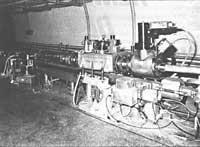thousandth part of the second
1998/05/01 Bandres Unanue, Luis Iturria: Elhuyar aldizkaria
For those of us who measure time normally, the thousandth second is almost nothing, that is, it is almost zero. These small time intervals were measured for the first time recently. When time went through the height of the Sun or the shadow of a stick, there was no way or need to talk about the minutes. Even the minute was too small to have exactly the size of your interval.
Formerly human life was not as fast as today and its clocks, both sun and water or sand, had no mark to measure minutes. XVIII. Until the beginning of the 19th century the clocks had no minute hands, but they did. At the beginning of the 20th century, second hands also appeared.
What can happen at the door of the thousandth second? Many things! A train will not exceed three centimeters, but the sound will reach thirty-three centimeters and a plane will cover half a meter; the Earth will travel the Sun thirty meters and light three hundred kilometers.
If all the small beings around us were able to reason, they would take into account a time interval that probably equals the thousandth second. A mosquito, for example, moves its wings 500 times in a second, so the thousandth second is the time it takes to raise or lower the wings.
Man cannot move his hands or feet so quickly. The lightest movement of the human being is blinking, that is, opening and closing the eyelids, we do it so fast that with sight we do not realize. Although this movement is very light, if we measure it for one thousandth of the second it is quite slow. Due to very precise measurements, in a “blink of an eye” approximately thousandths of four hundred seconds pass.
Blinking has the following stages: lowering the eyelid around the thousandth of the eighties; keeping the eye closed about the thousandth of the hundred and fifty seconds; and finally lifting the eyelid over the thousandth of the hundred and seventy seconds. Therefore, an “open and closed eye” that is used to express a brief time in regular conversations is not so short.
If our nervous system worked on the scale of the thousandth second, we would see the world around us very different. The writer Wells, in the story An Ultramodern Accelerator, shows us this amazing world. The protagonists of the story, after drinking a special liquid, are able to detect phenomena that occur very quickly as fragments and as slow. Let's look at some examples that appear in the story:
- Have you ever seen that a curtain is stuck in the window?
I looked at the curtain and it seemed that it was still, that the angle that lifted the wind was still like that.
- No, never, I said it. Amazing!
- And this? he said to me as he opened the hand holding the glass.
I thought the glass would fall and break, but it did not move: it remained still as if it were hung in the air.
- As you know, when things fall, in the first second five meters pass – Gibbern said. The glass is already making those five meters, but understand it, it has not yet been a hundred seconds. This will give you a clear idea of the strength of my “accelerator”.
The glass was slowly descending. Gibbern passed his hand over and under the forest... I looked out the window and saw a cyclist who wanted to catch a car that stood firm in place, with his dust odei behind.
We were surprised by a fully petrified horse cart. The top of the wheels, the legs of the horses, the end of the knight and the lower cheek of the goalkeeper (which on this occasion began to kill) were very slow but moving, while the rest of the parts of this amazing horse cart remained still. Travelers inside looked like states.
After drinking “accelerator” everything I said, thought and did happened while the others “opened and closed their eyes”.
In this sense, what is the shortest time we can currently measure? At the beginning of this century that ends this interval was ten thousandths of a second, but physical children can measure in their laboratories one hundred billion seconds (i.e., 1/100,000,000,000). That is, comparing this interval with the second equals comparing the same second to 3,000 years.
When Weils wrote “An Ultramodern Accelerator,” he surely didn’t think we could ever measure this small interval, but he had also seen images created by his fantasy… of course on the screen. The device we know as “slow motion” gives us slowly on the screen phenomena that are actually lighter.
Slow motion is actually a steamer, but instead of making twenty-four shots in a second, as conventional filmmakers do, it does much more. When the scenes made through it are taken on the screen at a normal speed, that is, twenty photons per second, the observer sees the movements “stretched out”. With this type of apparatus, we are able to see the phenomena written by Wells… to their extent.

Gai honi buruzko eduki gehiago
Elhuyarrek garatutako teknologia




